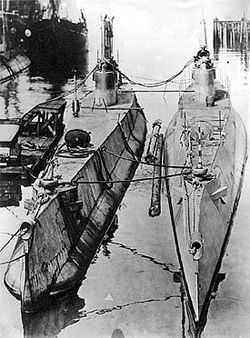HMCS CC-2
 HMCS CC-1 and HMCS CC-2 | |
| Career (Canada) | |
|---|---|
| Name: | CC-2 |
| Builder: | Seattle Construction and Drydock Company |
| Launched: | December 31, 1913 |
| Commissioned: | August 6, 1914 |
| Fate: | Paid off and scrapped in 1920 |
| General characteristics | |
| Class and type: | CC-class submarine |
| Displacement: | 313 long tons (318 t) surfaced 373 long tons (379 t) submerged |
| Length: | 144 ft (44 m) |
| Beam: | 15 ft (4.6 m) |
| Draught: | 11 ft (3.4 m) |
| Speed: | 13 knots (24 km/h) |
| Complement: | 18 (2 officers, 16 men) |
| Armament: | 5 × 18 in (457 mm) torpedo tubes |
| Service record | |
|---|---|
| Part of: | Royal Canadian Navy |
HMCS CC-2 was a CC-class submarine used by the Royal Canadian Navy. The ship was launched in 1913 in Seattle, Washington as the submarine Antofagasta for Chile.[1] This deal fell through and the boat, along with HMCS CC-1, was offered to British Columbia's premier Sir Richard McBride, just nine days before the United Kingdom's declaration of war in 1914.[2][3] On August 4, 1914, the day war was declared, the boat departed at night (to maintain secrecy from the Chilean, German, and U.S. governments) for handover to BC authorities near Victoria, BC.[4] The Dominion Government of Canada later ratified the sale although there was a Parliamentary investigation of the cost of both boats, over twice the annual budget for the entire RCN in 1913-14.[3] The submarine entered into service for the RCN, with its near twin, as HMCS CC-2 on 6 August 1914.
Royal Canadian Navy Service
The ship was assigned to the west coast in the home port of Esquimalt, British Columbia, and conducted training operations and patrols for three years. Together with HMCS Rainbow, CC-1 and CC-2 were the only Canadian or British ships defending the west coast of Canada between 1914 and 1917. Britain had tasked the defence of British Columbia to the Imperial Japanese Navy's North American Task Force.[5] In 1917 the submarine was transferred to the east coast. The transfer to the east coast was for both submarines of this class, with their mother ship, the submarine tender HMCS Shearwater. Its transit through the Panama Canal was the first time a Canadian warship transitted the Panama Canal under the White Ensign. It arrived in Halifax for preparation to send the two subs to the Mediterranean and Europe. Deemed unsafe for transatlantic crossing, the submarine was held in Halifax as a Training Assistance Boat.[6] Her veteran crew were highly valued but were not able to conduct any other operations than training. Her continued use was too expensive, and her unseaworthiness resulted in her being paid off, and disposed of in 1920.
See also
References
- ↑ Submariners Association of Canada
- ↑ "Canada's military submarines". CBC News. November 1, 2005. Retrieved August 30, 2009.
- ↑ 3.0 3.1 Starr J. Sinton. Retrieved October 10, 2010.
- ↑ Starr J. Sinton. Retrieved October 12, 2010
- ↑ Sandy McClearn (2009). "CC Type". Haze Gray & Underway. Retrieved August 30, 2009.
External Links and Bibliography
- Macpherson, Keneth R. and Burgess, John. Ships of Canada's Naval Forces: 1910-2002 (April 2004 ed.). Vanwell Publishing; 3 edition. ISBN 1-55125-072-1. - pages in book: 324
- Perkins, David (2001). The Canadian Submarine Service in Review. Vanwell. p. 208. ISBN 1-55125-031-4.
- Sinton, Starr J. CC1 and CC2 - British Columbia's Submarine Fleet. Retrieved October 12, 2010.
| ||||||||||